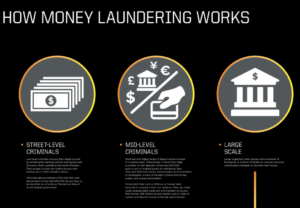INTRODUCTION
Money laundering is a criminal activity that involves concealing the origins of illegally obtained money, typically through a series of complex financial transactions, with the aim of making it appear legitimate. This illicit practice enables criminals to enjoy the proceeds of their unlawful activities while evading detection by law enforcement authorities. Money laundering can take various forms, including illegal money transfers and asset concealment, each presenting unique challenges and implications for financial systems, law enforcement, and global security. In this comprehensive analysis, we’ll delve into the complexities of money laundering, examining its methods, impacts, regulatory frameworks, and strategies for combating this pervasive threat to the integrity of financial systems.

1. Illegal Money Transfers: Illegal money transfers, also known as wire transfers or fund remittances, involve the movement of illicit funds across borders or within financial systems to disguise their criminal origins. Criminal organizations, corrupt individuals, and terrorist groups use various methods to transfer illicit proceeds, including cash smuggling, shell companies, cryptocurrency transactions, and underground banking networks.

2. Characteristics of Illegal Money Transfers:
- Illegal money transfers often involve sophisticated techniques and networks to launder illicit funds and obscure the trail of criminal proceeds.
- Money launderers may exploit weaknesses in financial regulations, banking systems, and international jurisdictions to facilitate cross-border transfers and evade detection by authorities.
- The use of anonymous payment methods, such as virtual currencies, prepaid cards, and digital wallets, enables criminals to launder money with greater anonymity and efficiency.
3. Impacts of Illegal Money Transfers:
- Illegal money transfers undermine the integrity of financial systems, erode public trust in institutions, and facilitate criminal activities, including drug trafficking, terrorism financing, corruption, and organized crime.
- Laundered funds can distort economic markets, inflate asset prices, and contribute to money laundering “cycles” that perpetuate criminal enterprises and corruption.
- The cross-border nature of illegal money transfers poses challenges for law enforcement agencies, regulatory authorities, and international cooperation efforts to combat money laundering effectively.
4. Asset Concealment: Asset concealment involves the covert placement, layering, and integration of illicit funds into legitimate financial assets, businesses, or investments to disguise their criminal origins and ownership. Money launderers use various strategies to conceal assets, including shell companies, offshore accounts, real estate transactions, and complex corporate structures.
5. Characteristics of Asset Concealment:
- Asset concealment requires money launderers to create a complex web of transactions and entities to obscure the true ownership and origin of illicit funds.
- Offshore jurisdictions with lax regulatory oversight, secrecy laws, and tax havens provide fertile ground for asset concealment and money laundering activities.
- Money launderers may employ professional intermediaries, such as lawyers, accountants, and trust services, to facilitate asset concealment schemes and exploit legal loopholes.
6. Impacts of Asset Concealment:
- Asset concealment undermines transparency, accountability, and financial integrity, allowing criminals to enjoy the proceeds of their illicit activities while evading detection and prosecution.
- Concealed assets may be used to fund additional criminal ventures, finance illicit operations, or support a lavish lifestyle, further perpetuating criminality and corruption.
- The use of complex corporate structures, nominee directors, and offshore accounts complicates efforts to trace and recover laundered assets, hampering law enforcement investigations and asset forfeiture proceedings.
7. Regulatory Frameworks and Enforcement Measures:
- Combatting money laundering requires robust regulatory frameworks, enhanced due diligence requirements, and effective enforcement measures to detect, deter, and disrupt illicit financial activities.
- Financial institutions play a critical role in implementing anti-money laundering (AML) and know-your-customer (KYC) measures to identify suspicious transactions, report suspicious activity, and prevent money laundering risks.
- International cooperation, information sharing agreements, and mutual legal assistance treaties (MLATs) are essential for coordinating efforts to combat money laundering across borders and jurisdictions.
8. Strategies for Combating Money Laundering:
- Strengthening anti-money laundering laws, regulations, and enforcement mechanisms to enhance transparency, accountability, and cooperation among financial institutions, regulators, and law enforcement agencies.
- Implementing risk-based approaches to anti-money laundering compliance, focusing resources on high-risk sectors, jurisdictions, and transactions to prioritize efforts and maximize effectiveness.
- Enhancing technological capabilities, data analytics, and financial intelligence tools to detect patterns, trends, and anomalies indicative of money laundering activity in real-time.

9. Conclusion: Money laundering poses significant risks to the integrity of financial systems, national security, and global stability, requiring concerted efforts from governments, financial institutions, regulators, and international organizations to combat effectively. By strengthening regulatory frameworks, enhancing enforcement measures, and promoting international cooperation, stakeholders can mitigate the threats posed by illegal money transfers and asset concealment, safeguarding financial systems and preserving the integrity of global markets.
In conclusion, money laundering through illegal money transfers and asset concealment represents a pervasive threat to the integrity of financial systems, national security, and global stability. By understanding the methods, impacts, regulatory frameworks, and strategies for combating money laundering, stakeholders can work together to detect, deter, and disrupt illicit financial activities, safeguarding financial systems and preserving the integrity of global markets.



